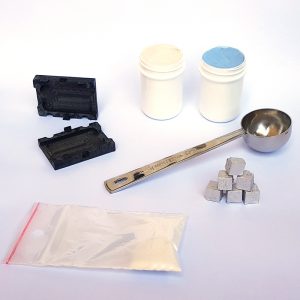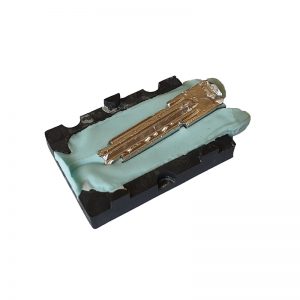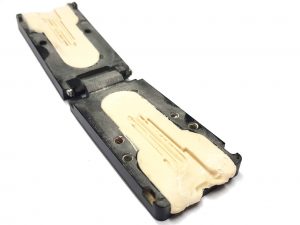
(English version below)
Oui, on peut mouler des clés, comme dans les films !
Il existe même plusieurs méthodes qui s’adaptent à toutes les situations (rapidité, précision, clés complexes, clés avec aimant ou mobile).
La méthode la plus utilisée de nos jours utilise des résines silicones qui vont polymériser en quelques minutes voire quelques secondes selon le modèle choisi (et la température ambiante).
Ces résines ont la capacité de mouler des clés avec une précision de l’ordre du micron et de conserver leur forme sans risque de déformation après démoulage.
L’action chimique de polymérisation étant relativement rapide, la préparation doit se faire au dernier moment. Et une fois la clé insérée correctement, il faut attendre que la polymérisation soit complète avant d’ouvrir le moule (souvent à l’aide d’un cutter).
Cependant, la méthode “à l’ancienne” n’a rien à envier à cette nouvelle méthode sur certains aspects. En effet, elle consiste à utiliser une “pâte à modeler” spécifique, qui va simplement prendre la forme de la clé, avec l’inconvénient que la pâte reste déformable après démoulage de la clé.
Le principal avantage de cette méthode réside dans la possibilité de préparer la boîte d’empreinte à l’avance, et la prise d’empreinte ne prend que 5 secondes si elle est effectuée correctement. Donc une clé prêtée seulement 5 secondes peut très bien être moulée et dupliquée sans que vous ne vous en rendiez compte.
Et une fois le moule réalisé en résine ou pâte à modeler, on vient simplement y couler un métal à basse température de fusion, ou de la soudure à froid liquide.
On obtient alors une duplication parfaite de la clé (bien que généralement plus fragile qu’une véritable clé), y compris des modèles “incopiables”, en seulement quelques minutes, et sans l’aide d’un serrurier.
Petite anecdote, ayant été appelé suite à une intrusion illicite il y a quelques années, il n’a pas été trouvé de traces d’effraction sur la porte en question. Cependant, l’une des clés originales présentait des rayures profondes et incohérentes avec son utilisation normale.
Il a été découvert qu’un stagiaire avait acheté un “kit de moulage” quelques jours avant la fin de son stage dans cette entreprise et avait effectué un moulage du Passe Général alors qu’il y avait accès légitimement. Lorsqu’il a utilisé sa copie moulée, il était insoupçonnable. Nous avons réalisé une analyse forensique des clés qui a permis d’identifier la technique et d’élargir les recherches qui ont mené à lui.
Voilà donc une nouvelle raison de “planquer vos clés” !
Attention, je ne dis pas nécessairement tout dans cet article pour ne pas risquer de former de futurs cambrioleurs, et il est aussi possible de mouler certaines clés brevetées munies d’aimants ou de pièces mobiles presque aussi facilement.
N’hésitez pas à me contacter si vous souhaitez vous informer ou vous former aux méthodes de Pentest Physique ou aux moyens de protection.
#Sensibilisation #Formation #Atelier #Crochetage #PentestPhysique
/////English Version/////
Yes, keys can be molded James Bond style, for real!
There are even several methods that will adapt to all possible situations (speed, precision, complex keys, keys with a magnet or a moving part).
The most currently used method is using silicone resins that will polymerize in a few minutes or even seconds depending on the model chosen (and the temperature to some extent).
These resins can mold keys with the precision of a micrometer, and keep the shape without risk of later deformation once the molding is completed.
The chemical reaction being pretty quick, preparation must be made at the last moment. And once the key is correctly inserted, it is necessary to wait for the polymerization to do its job, before the mold is open (often using an X-acto knife).
Though, the “old school” method has nothing to envy that new method on some aspects. As a matter of fact, this method is using a specific modeling clay that will simply take the shape of the key, with the drawback of being prone to later deformation.
The main advantage of this method is that the molding box can be prepared in advance, and the actual molding process will take only 5 seconds if done properly. That means that a key lent only 5 seconds can possibly be molded and duplicated without the user noticing anything.
And once the mold is ready, either in silicone or clay, one can simply pour a low melting temperature metal or a cold-welding liquid.
A perfect duplicate of the key is then obtained (although generally more fragile than a normal key), including so-called unduplicable keys, in a matter of minutes, without the help of a locksmith.
Small anecdote, I have been called once after an unlawful intrusion, and no trace of the opening has been found on the door. Though, one of the original keys featured a certain amount of deep scratches, inconsistent with a normal use of the key.
It has been discovered that a trainee did buy a “molding kit” just a few days before the end of his internship in this company, and did make a mold of the MasterKey while he had a legitimate access to it. When he used the molded duplicate, he was above suspicion. We conducted a forensic analysis of the keys that determined the technique used and oriented the research that led to him.
This is then a new reason to “Hide your keys”!
Watch out, I’m not explaining all techniques in this article as I don’t want to teach wannabe burglars, and there are other molding techniques that will also duplicate patented keys with magnets or moving elements almost as easily.
Feel free to contact me if you want more information or attend to a training in Physical Pentesting or Physical Protection.
#Sensitization #Training #Workshop #Lockpicking #PhysicalPentest


 septembre 11th, 2019
septembre 11th, 2019  Frenchkey
Frenchkey 



 Posted in
Posted in